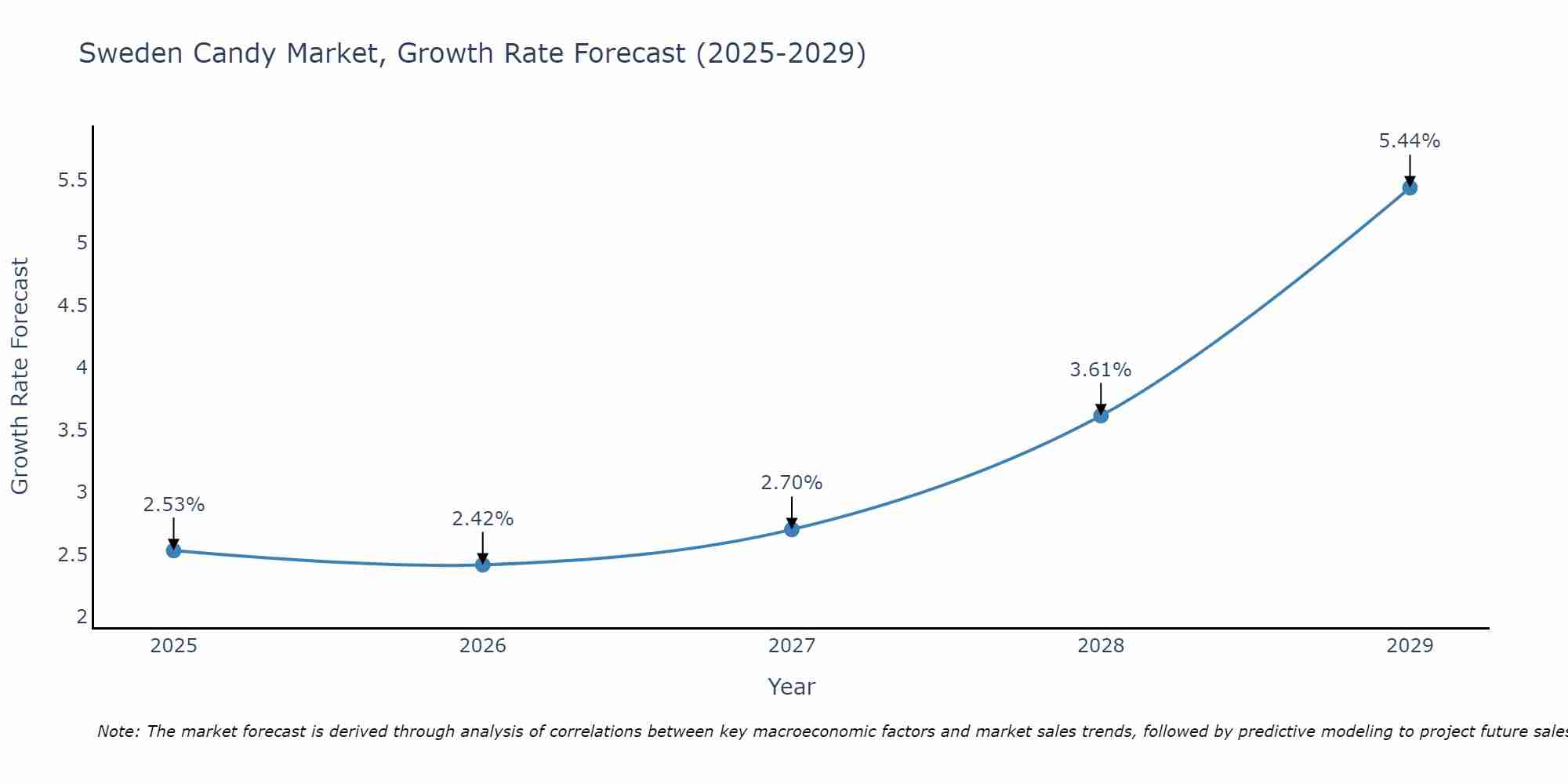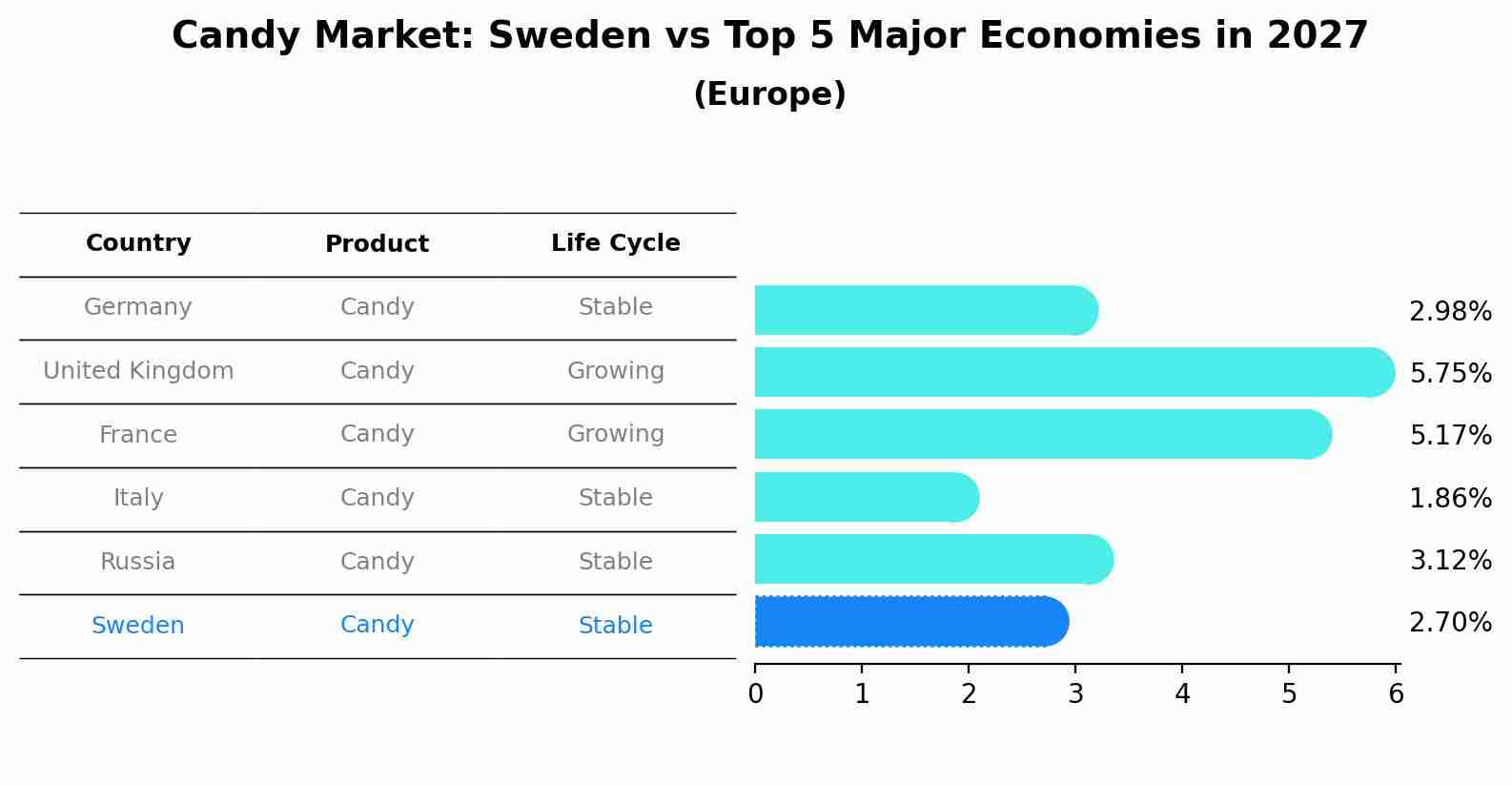Sweden Candy Market (2025-2031) | Size, Growth, Forecast, Revenue, Companies, Share, Outlook, Value, Segmentation, Industry, Trends & Analysis
| Product Code: ETC5378362 | Publication Date: Nov 2023 | Updated Date: Apr 2025 | Product Type: Market Research Report | |
| Publisher: 6Wresearch | Author: Bhawna Singh | No. of Pages: 60 | No. of Figures: 30 | No. of Tables: 5 |
Sweden Candy Market Size Growth Rate
The Sweden Candy Market is projected to witness mixed growth rate patterns during 2025 to 2029. The growth rate starts at 2.53% in 2025 and reaches 5.44% by 2029.

Candy Market: Sweden vs Top 5 Major Economies in 2027 (Europe)
By 2027, the Candy market in Sweden is anticipated to reach a growth rate of 2.70%, as part of an increasingly competitive Europe region, where Germany remains at the forefront, supported by United Kingdom, France, Italy and Russia, driving innovations and market adoption across sectors.

Sweden Candy Market Overview
The candy market in Sweden is vibrant and diverse, reflecting a rich tradition of confectionery. Swedish consumers have a strong preference for gummy candies and licorice, which are deeply rooted in the country culture. The market has been evolving with trends such as health-conscious choices, leading to the introduction of sugar-free and organic candy options. Furthermore, seasonal promotions and themed products for holidays and festivities play a significant role in driving sales. As manufacturers innovate with flavors and textures, the candy market is anticipated to grow, bolstered by both local brands and international entrants.
Drivers of the market
The Swedish candy market thrives on the nations deep-rooted candy culture, particularly the tradition of "lördagsgodis," or Saturday candy. This cultural phenomenon encourages families to indulge in sweets during the weekend, ensuring a consistent demand for various confectionery products. Additionally, the growing trend of premium and artisanal candies, often made with high-quality, natural ingredients, caters to health-conscious consumers seeking indulgence without compromising on quality. Innovative product offerings, including vegan and sugar-free options, also contribute to market expansion as they appeal to a broader audience. Seasonal events and celebrations further bolster candy sales, making the market vibrant and dynamic.
Challenges of the market
The candy market in Sweden is struggling with growing health concerns among consumers, as people become more conscious about sugar consumption and its health implications. The demand for sugar-free and healthier alternatives is rising, forcing traditional candy manufacturers to adapt or face declining sales. Moreover, the market is increasingly competitive, with local and international brands vying for shelf space. Sustainability issues, particularly around packaging, are adding another layer of pressure, as consumers push for more eco-friendly solutions.
Government Policy of the market
The candy market in Sweden is a significant part of the confectionery sector, with a strong consumer preference for both traditional and innovative sweets. The Swedish government has implemented policies targeting public health, which influence this market. For instance, the country sugar tax policies and health campaigns encourage consumers to reduce sugar intake. The government also supports the use of natural sweeteners and reduced-sugar alternatives. Additionally, Sweden adheres to the EU food safety standards, which regulate the use of artificial colors, preservatives, and other additives in candy production.
Key Highlights of the Report:
- Sweden Candy Market Outlook
- Market Size of Sweden Candy Market, 2024
- Forecast of Sweden Candy Market, 2031
- Historical Data and Forecast of Sweden Candy Revenues & Volume for the Period 2021-2031
- Sweden Candy Market Trend Evolution
- Sweden Candy Market Drivers and Challenges
- Sweden Candy Price Trends
- Sweden Candy Porter`s Five Forces
- Sweden Candy Industry Life Cycle
- Historical Data and Forecast of Sweden Candy Market Revenues & Volume By Product Type for the Period 2021-2031
- Historical Data and Forecast of Sweden Candy Market Revenues & Volume By Chocolate Candy for the Period 2021-2031
- Historical Data and Forecast of Sweden Candy Market Revenues & Volume By Non-Chocolate Candy for the Period 2021-2031
- Historical Data and Forecast of Sweden Candy Market Revenues & Volume By Distribution for the Period 2021-2031
- Historical Data and Forecast of Sweden Candy Market Revenues & Volume By Supermarkets and Hypermarkets for the Period 2021-2031
- Historical Data and Forecast of Sweden Candy Market Revenues & Volume By Convenience Stores for the Period 2021-2031
- Historical Data and Forecast of Sweden Candy Market Revenues & Volume By Specialist Retailers for the Period 2021-2031
- Historical Data and Forecast of Sweden Candy Market Revenues & Volume By Online Retail for the Period 2021-2031
- Historical Data and Forecast of Sweden Candy Market Revenues & Volume By Others for the Period 2021-2031
- Sweden Candy Import Export Trade Statistics
- Market Opportunity Assessment By Product Type
- Market Opportunity Assessment By Distribution
- Sweden Candy Top Companies Market Share
- Sweden Candy Competitive Benchmarking By Technical and Operational Parameters
- Sweden Candy Company Profiles
- Sweden Candy Key Strategic Recommendations
Frequently Asked Questions About the Market Study (FAQs):
1 Executive Summary |
2 Introduction |
2.1 Key Highlights of the Report |
2.2 Report Description |
2.3 Market Scope & Segmentation |
2.4 Research Methodology |
2.5 Assumptions |
3 Sweden Candy Market Overview |
3.1 Sweden Country Macro Economic Indicators |
3.2 Sweden Candy Market Revenues & Volume, 2021 & 2031F |
3.3 Sweden Candy Market - Industry Life Cycle |
3.4 Sweden Candy Market - Porter's Five Forces |
3.5 Sweden Candy Market Revenues & Volume Share, By Product Type, 2021 & 2031F |
3.6 Sweden Candy Market Revenues & Volume Share, By Distribution, 2021 & 2031F |
4 Sweden Candy Market Dynamics |
4.1 Impact Analysis |
4.2 Market Drivers |
4.3 Market Restraints |
5 Sweden Candy Market Trends |
6 Sweden Candy Market Segmentations |
6.1 Sweden Candy Market, By Product Type |
6.1.1 Overview and Analysis |
6.1.2 Sweden Candy Market Revenues & Volume, By Chocolate Candy, 2021-2031F |
6.1.3 Sweden Candy Market Revenues & Volume, By Non-Chocolate Candy, 2021-2031F |
6.2 Sweden Candy Market, By Distribution |
6.2.1 Overview and Analysis |
6.2.2 Sweden Candy Market Revenues & Volume, By Supermarkets and Hypermarkets, 2021-2031F |
6.2.3 Sweden Candy Market Revenues & Volume, By Convenience Stores, 2021-2031F |
6.2.4 Sweden Candy Market Revenues & Volume, By Specialist Retailers, 2021-2031F |
6.2.5 Sweden Candy Market Revenues & Volume, By Online Retail, 2021-2031F |
6.2.6 Sweden Candy Market Revenues & Volume, By Others, 2021-2031F |
7 Sweden Candy Market Import-Export Trade Statistics |
7.1 Sweden Candy Market Export to Major Countries |
7.2 Sweden Candy Market Imports from Major Countries |
8 Sweden Candy Market Key Performance Indicators |
9 Sweden Candy Market - Opportunity Assessment |
9.1 Sweden Candy Market Opportunity Assessment, By Product Type, 2021 & 2031F |
9.2 Sweden Candy Market Opportunity Assessment, By Distribution, 2021 & 2031F |
10 Sweden Candy Market - Competitive Landscape |
10.1 Sweden Candy Market Revenue Share, By Companies, 2024 |
10.2 Sweden Candy Market Competitive Benchmarking, By Operating and Technical Parameters |
11 Company Profiles |
12 Recommendations | 13 Disclaimer |
- Single User License$ 1,995
- Department License$ 2,400
- Site License$ 3,120
- Global License$ 3,795
Search
Related Reports
- Portugal Occupational Health & Safety Services Market (2025-2031) | Strategy, Consumer Insights, Analysis, Investment Trends, Opportunities, Growth, Size, Share, Industry, Revenue, Segments, Value, Segmentation, Supply, Forecast, Restraints, Outlook, Competition, Drivers, Trends, Demand, Pricing Analysis, Competitive, Strategic Insights, Companies, Challenges
- Netherlands Occupational Health and Safety Services Market (2025-2031) | Strategy, Consumer Insights, Analysis, Investment Trends, Opportunities, Growth, Size, Share, Industry, Revenue, Segments, Value, Segmentation, Supply, Forecast, Restraints, Outlook, Competition, Drivers, Trends, Demand, Pricing Analysis, Competitive, Strategic Insights, Companies, Challenges
- Belgium and Luxembourg Facility Management Market (2025-2031) | Strategy, Consumer Insights, Analysis, Investment Trends, Opportunities, Growth, Size, Share, Industry, Revenue, Segments, Value, Segmentation, Supply, Forecast, Restraints, Outlook, Competition, Drivers, Trends, Demand, Pricing Analysis, Competitive, Strategic Insights, Companies, Challenges
- Russia Women Intimate Apparel Market (2025-2031) | Strategy, Consumer Insights, Analysis, Investment Trends, Opportunities, Growth, Size, Share, Industry, Revenue, Segments, Value, Segmentation, Supply, Forecast, Restraints, Outlook, Competition, Drivers, Trends, Demand, Pricing Analysis, Competitive, Strategic Insights, Companies, Challenges
- Africa Chocolate Market (2025-2031) | Size, Share, Trends, Growth, Revenue, Analysis, Forecast, industry & Outlook
- Global Hydroxychloroquine And Chloroquine Market (2025-2031) | Industry, Trends, Size, Outlook, Growth, Value, Companies, Revenue, Analysis, Share, Forecast
- Saudi Arabia Plant Maintenance Market (2025-2031) | Industry, Size, Growth, Revenue, Value, Companies, Forecast, Analysis, Share & Trends
- Taiwan Electric Truck Market (2025-2031) | Outlook, Industry, Revenue, Size, Forecast, Growth, Analysis, Share, Companies, Value & Trends
- South Korea Electric Bus Market (2025-2031) | Outlook, Industry, Companies, Analysis, Size, Revenue, Value, Forecast, Trends, Growth & Share
- Africa Low Temperature Powder Coating Market (2025-2031) | Companies, Competition, Size, Challenges, Segmentation, Trends, Competitive, Industry, Supply, Strategy, Investment Trends, Growth, Segments, Restraints, Strategic Insights, Revenue, Share, Forecast, Drivers, Analysis, Pricing Analysis, Demand, Consumer Insights, Value, Opportunities, Outlook
Industry Events and Analyst Meet
Our Clients
Whitepaper
- Middle East & Africa Commercial Security Market Click here to view more.
- Middle East & Africa Fire Safety Systems & Equipment Market Click here to view more.
- GCC Drone Market Click here to view more.
- Middle East Lighting Fixture Market Click here to view more.
- GCC Physical & Perimeter Security Market Click here to view more.
6WResearch In News
- Doha a strategic location for EV manufacturing hub: IPA Qatar
- Demand for luxury TVs surging in the GCC, says Samsung
- Empowering Growth: The Thriving Journey of Bangladesh’s Cable Industry
- Demand for luxury TVs surging in the GCC, says Samsung
- Video call with a traditional healer? Once unthinkable, it’s now common in South Africa
- Intelligent Buildings To Smooth GCC’s Path To Net Zero













